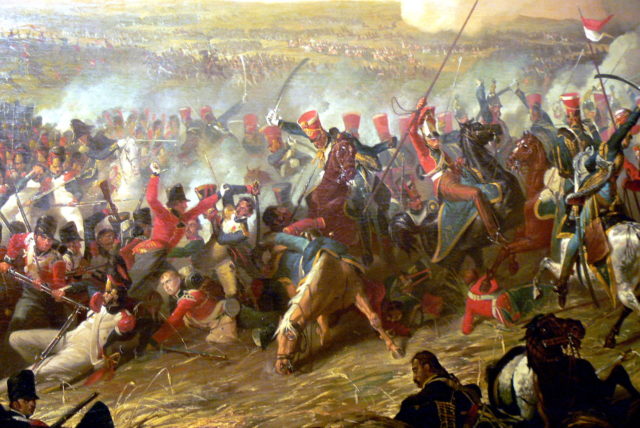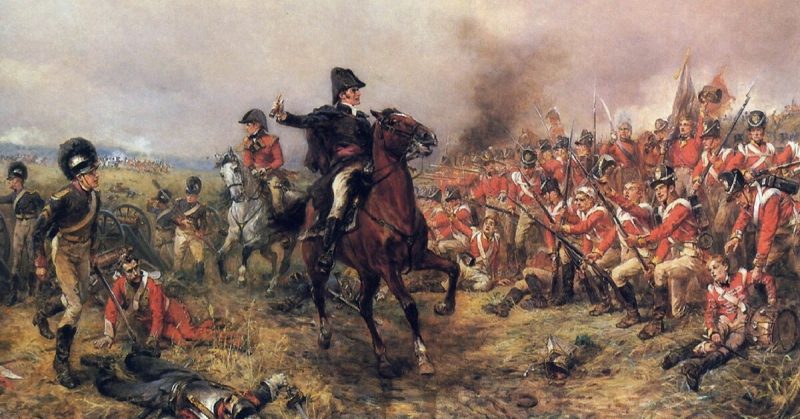The armies that fought against Napoleon are some of the most celebrated in British history. Under the leadership of the Duke of Wellington, they drove the French back through Portugal and Spain into France, ending Napoleon’s rule. When the emperor returned in 1815, they were the bulk of the forces that defeated him at Waterloo.
Recruitment
Recruitment was a problem.
Firstly, a huge amount of manpower was required. Wellington’s armies on campaign drew attention as they were actively fighting the French. Thousands of soldiers were also committed elsewhere; whether holding the colonies, defending the homeland, or, from 1812, fighting the Americans.
Secondly, a career in the army was not well regarded or well rewarded outside the officer corps. It was not appealing to anyone who had other prospects.
With 16,000-24,000 casualties per year suffered in the Napoleonic fighting, scores of men were needed. Those recruited were the sort Wellington referred to as the scum of the earth. Uneducated, unhealthy, undisciplined, and often with a history of crime; they were the best that could be found.
Equipment
Apart from soldiers, the other requirement of the army was equipment.
Most soldiers were regular infantry. They dressed in bright uniforms earning the nickname of “redcoats.”
Their primary weapon was a musket. It was not an accurate weapon and had not substantially changed in a hundred years. Prussian tests showed that, even without the pressure of battle, troops firing those weapons hit enemy troops 25% of the time at 225 yards. It only increased to 60% at 75 yards. Its effectiveness depended upon mass firing, not sharp shooting.
Infantrymen also carried bayonets, which they could fix onto their muskets for close combat.
Experience
The experience of the troops was extremely varied. Some had served in the colonies but had not been involved in any action. Others had fought under Wellington in India. Some had battled the French during Britain’s limited land interventions earlier in the war. A large number had barely been through basic training, never mind fighting in a conflict.
Drill
The key to turning all those soldiers and their limited weapons into a deadly force was to drill them. With rigorous training, repeated over and over, disparate men were transformed into deadly fighting formations.
There were two critical aspects of British infantry drill. One was loading and firing – to ensure devastating volleys of lead could be launched quickly, consistently, and repeatedly. The other was maneuvering – shifting blocks of men backward, forward, and side to side around the field without descending into chaos.
If both were done well, infantry could be devastating to an approaching foe. They could be used in line against other infantry or in square formations to fend off cavalry.
Discipline
Wellington was regarded as a particularly hard disciplinarian. Strict control was used to achieve the desired result. Flogging was common, using the vicious cat-of-nine-tails. Hanging was also wielded on those breaking the most serious rules. It would not have been deemed excessive as many civilian crimes also led to the gallows.

Officers
Discipline was much harder to enforce among the officers.
Officer ranks were bought and sold. The men occupying them were almost universally from the British upper class. They regarded their commissions as property. No court-martial was likely to deprive a man of his rank, no matter how poorly he performed.
Those men had access to the best education money could buy. Some were smart, gifted, and courageous. Others were undisciplined, unintelligent liabilities that Wellington could not get rid of.
The Regimental System
Officers bought their way up the ranks, moving from one regiment to another as the chance for promotion arose. Privates and NCOs, on the other hand, nearly always stayed where they were.
It became one of the great strengths of the British regimental system. By fighting and training together, men learned to work well in their small groups. Not wanting to shame themselves in front of friends and comrades helped in maintaining discipline.
Wellington might have called them the scum of the earth, but he relied on those men and knew their great value once trained and experienced.
Light Troops and Grenadiers
The elite troops of each infantry company were the flanking divisions – one the grenadiers and one light infantry.
The grenadiers were recruited from among the most powerfully built of the experienced soldiers. Their role was no longer primarily to throw grenades. Instead, they were the hardiest fighters and shock troops.
The light infantry were also veterans. Nimble sharpshooters trained in open order fighting, they were often equipped with rifles. Those weapons let them fight as skirmishers and more accurately target specific enemies.
Cavalry
The British cavalry was generally equipped with high-quality horses. Like the flanking companies, they divided into two types.
Heavy cavalry were big men on large mounts. They were shock troops, trained to charge straight into enemy lines and break them open.
The light cavalry had smaller horses. Their main roles were reconnaissance, screening, and the pursuit of a broken enemy.
Artillery
Wellington never had as much artillery as he would have liked. It had a relatively short range by modern standards, reaching an extreme of 1,000 yards. It was fielded close to the fray and could strike the enemy at a greater distance than any other weapon. As well as being used to break fortifications in sieges, it was used to break up formations and turn flanks before a battlefield assault.
A Mixed Army
Wellington’s army was very mixed. Drunk officers led criminal recruits next to hardened veterans and smart strategists. Cavalry, artillery and specialist infantry supported the main lines.
Through drill, discipline, and the regimental system, Wellington coordinated the unruly bunch and achieved victory.
Source:
David Chandler and Ian Beckett (Eds) (1994), The Oxford History of the British Army
John Keegan and Richard Holmes (1985), Soldiers
John Keegan (1987), The Mask of Command
